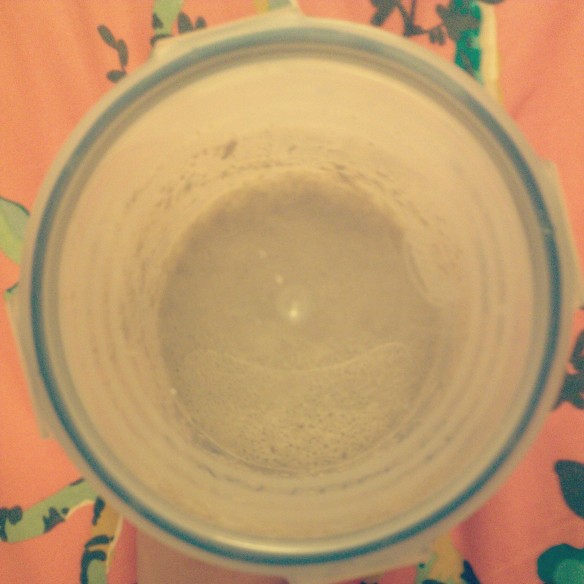Ask any good double act and they’ll tell you that the secret to their success lies in the blending of opposites; a subtle mix that both elevates and tames their individual traits that on their own can be, well, just that little bit too much. For me, a rich, velvety custard tart needs a serious side of tang to cut the creaminess down to size, and this rhubarb compote has that in spades. On top of the rhubarb’s natural sharpness, the pink peppercorns give a hint of smoky warmth as well as adding to the Pretty in Pink vibe – always a good thing in my book.
Author Archives: Natalie Glock
Pink grapefruit and almond tart
As a citrus fiend, I’m never happier than when I can turn something inherently sweet just that little bit sour, and I’ve found that when you want citrus to take centre stage don’t mess about, you need a diva; step forward the pink grapefruit. Ridiculously beautiful, pale pink segments, fragrant tropically-tinted zest and a juice that while sharp, has non of the bitterness of lemons or limes, she’s the complete package in my book – and so this zingy take on the classic Bakewell slice is my ode to her. If you need any more convincing of the pink grapefruit’s fabulousness, it translates into French as la pamplemousse rose, chic, non?
Pistachio and rose tiered cake
For those of you that have followed this blog for a while, you’ll know me and pistachios, we’re involved. There’s something delicate yet striking about them, all jade green and flecked with pink, so it was to my favourite nut I turned, when creating a birthday cake for my mum last week. The result was a light, moist, pistachio sponge laced with rose water, filled and covered with a pistachio French buttercream. I’ve never attempted a tiered cake before either but I was chuffed with how it turned out; chic, a little extravagant and completely delicious.
Diary of a sourdough starter: and then there was bread
And then there was bread!
13 days after first mixing together some four and water, I’ve cultivated active yeasts, kept my starter alive and finally produced a loaf. After the sponge had its overnight fermentation, I was pretty hopeful about getting some bread as the sponge was frothy, thick and bubbly, so the starter was alive and kicking. The final step before baking is to then make the dough by adding to the sponge mix, 300g of your chosen bread flour, 10g fine sea salt and an optional tablespoon of rapeseed or olive oil. Next step, knead until smooth and silky which fortunately I left to my very capable dough hook and Kitchen Aid that did the job in about 10mins. I then placed the dough in a lightly oiled bowl, covered with oiled cling film and left it to prove in a cool spot overnight. It’s important to know that sourdough isn’t going to rise quickly, or as high, as a regular loaf, but you should see it double in size given the right amount of time.
Finally it was bake day. I knocked back the dough and placed it into a floured, cane, proving basket and popped it into the airing cupboard for its second proving. Hugh suggests up to 3 hours in a warm place and this did seem enough time for my little loaf. The oven has to be super hot, 230°C / Gas Mark 8 at least, and it’s a good idea to pop the baking tray in for 5mins before baking. Dust the baking sheet with flour and then turn out the dough. Have a spray bottle full of water handy so that you can pop the loaf in and then spray the water over and round the loaf in the oven, this will help you to get a good crust. After 15mins I turned the temperature down to 200°C / Gas Mark 6, and cooked the loaf for another 25mins, until I had a hollow sounding base. Done at last. Don’t dive straight in, give the loaf about 20-30mins to cool and then go for it. I had my first few slices toasted and smothered in scrambled eggs, and they were a real treat. Tangy and nutty with a great crust, success!
As for Tallulah, I’m going to keep her of course. Once your starter is active you can continue to feed it everyday in the same way if you intend to make a loaf every day or so, but if you are baking less frequently, then simply add enough flour (no water) to form a stiff dough, then the starter won’t need feeding for 4 days or so. You’ll just need to add more water when you come to make a sponge again. If you won’t be baking for a while you can also freeze your starter, it will reactivate when thawed and fed. Clever little things aren’t they.
Diary of a sourdough starter: days 5-11
It’s fair to say that I’ve grown very fond of Tallulah. From day 5 onwards the feeding and discarding process has become loads more enjoyable purely because of how amazing she smells now. There’s a boozy, hoppy sweetness to the starter that reminds me of great beer, as well as the aroma of freshly risen dough. Just like Hugh said, you will get to the stage where you’ll want to bake with it, and I reckon I’m there. So, today – day 11 – instead of discarding half of the starter as per usual, I poured out 100ml into a large bowl, and added 250g of strong flour (I am sticking with my 50/50 split of wholemeal and white flours but you can use one or the other too) plus 275ml warm water. This is called the sponge and once you have mixed the ingredients together you then cover this with clingfilm and leave it to ferment overnight. I know, I know this sourdough business is long-winded but if I’m honest, that’s what I’m finding so exciting, it’s a labour of love. All that will remain is for me to turn the sponge into dough tomorrow, prove it overnight again, and then Sunday will be bake day, but I’ll put all of this in the final instalment after, hopefully, enjoying sourdough and scrambled eggs! Keep them crossed for me people.
From starter to sponge…
Related articles:
Gin and tonic mille-feuille
This delicate little tower of puff pastry represents the meeting of two very different, very beautiful things – French ostentation and crisp English cool – and it’s all thanks to gin. With a juniper-infused pastry cream and lemon slices candied in Tanqueray, this mille-feuille recipe has a lightness and subtlety to it that I love. It’s a taste of France, laced with an English summer’s night, which is pretty much my idea of heaven.
Diary of a sourdough starter: days 2 – 4
Apologies in advance for anyone not riveted by the development of my sourdough starter, I know she’s not the prettiest thing to look at but I have high hopes for the bread she’s hopefully going to give me. So, after the first 24 hours there were definite signs of life in the container, the surface was covered in little bubbles and then there was the smell. If you’re thinking about giving this a go, be prepared for this, it is not pleasant, it’s acidic and strong, a lot like gone off soured cream, but take it as a good sign that you’re heading in the right direction. On day two you add another 100g of flour (use the same combination of flour throughout the whole process) and enough water to maintain a consistency of thick paint. Back to the warm place, covered and sealed for another 24 hours.
Day 3, and the smell was at its worst today, blew my head off to be honest, so I quickly went about the next important stage. You now start to discard half the mix before then adding another 100g of flour and the same amount of water again. This discard and feed dance is what you must now for at least a week, by which time I’m hoping for a fruity, yeasty starter to bake with. This morning was day 4 and we seem to have turned a corner with the smell, much more subtle and dare I say it, bordering on yeasty! Onwards we go, and all for the love of bread. The things you do.
Here she is, my frothy friend.
Diary of a sourdough starter – day one
As a show of my commitment to carbs and sublime slices of toast, I’ve decide that it’s time for me to tackle sourdough – and before there can be sourdough, there must be a sourdough starter. Here she is, meet Tallulah!
I’ve opted to have my hand held throughout this leap into the bready unknown, by Hugh Fearnley-Whittingstall and his sourdough recipe from River Cottage Everyday. The recipe for the starter is simple, 100g of strong bread flour (a mix of 50g wholemeal bread flour, 50g white bread flour) plus as much warm water as it takes to create a batter that is the consistency of thick paint. Consistency achieved you have to leave your starter in a warm place to allow fermentation to start, so over the next 24 hours I’ll be checking for bubbles breaking the surface and the smell of natural yeasts doing their thang. Then, for the next 7-10 days I’ll be feeding and watering Tallulah with fresh flour and water everyday (discarding half of the original mix each time) until she’s a sweet-smelling, yeasty, bubbling mess, then and only then will there hopefully be bread. So, expect regular updates on me and her ladyship over the coming days, and feel free to leave me any sourdough tips in the comments below.
Related articles
Fig and hazelnut loaf
Baking bread is ridiculously satisfying. With a little bit of love and, let’s face it, not all that much care and attention, you can make something that simultaneously supplies comfort and nourishment, an innate sense of smugness and a not-to-be-underestimated arm workout. This loaf is my current favourite, packed full of sticky figs and toasted hazelnuts, it is moist and morish and absolutely wonderful with goat’s cheese. Feel free to dust liberally with flour a la artisans everywhere, this will only add to the sense of pride, trust me.
Orange and pomegranate cake
Grey January days, the kind when the rain’s making a racket on the windows and the sky has been bleached of its blue, are the days that demand cake. Something simple yet vibrant, something reminiscent of the colours and tastes of the last couple of weeks – and here she is. This sweet, syrupy loaf cake is a riot of orange and pink, with a satisfying pop of sharpness thanks to the generous smattering of pomegranate seeds. Sliced thick and served with a pot of tea, it’s the perfect start to the year.










